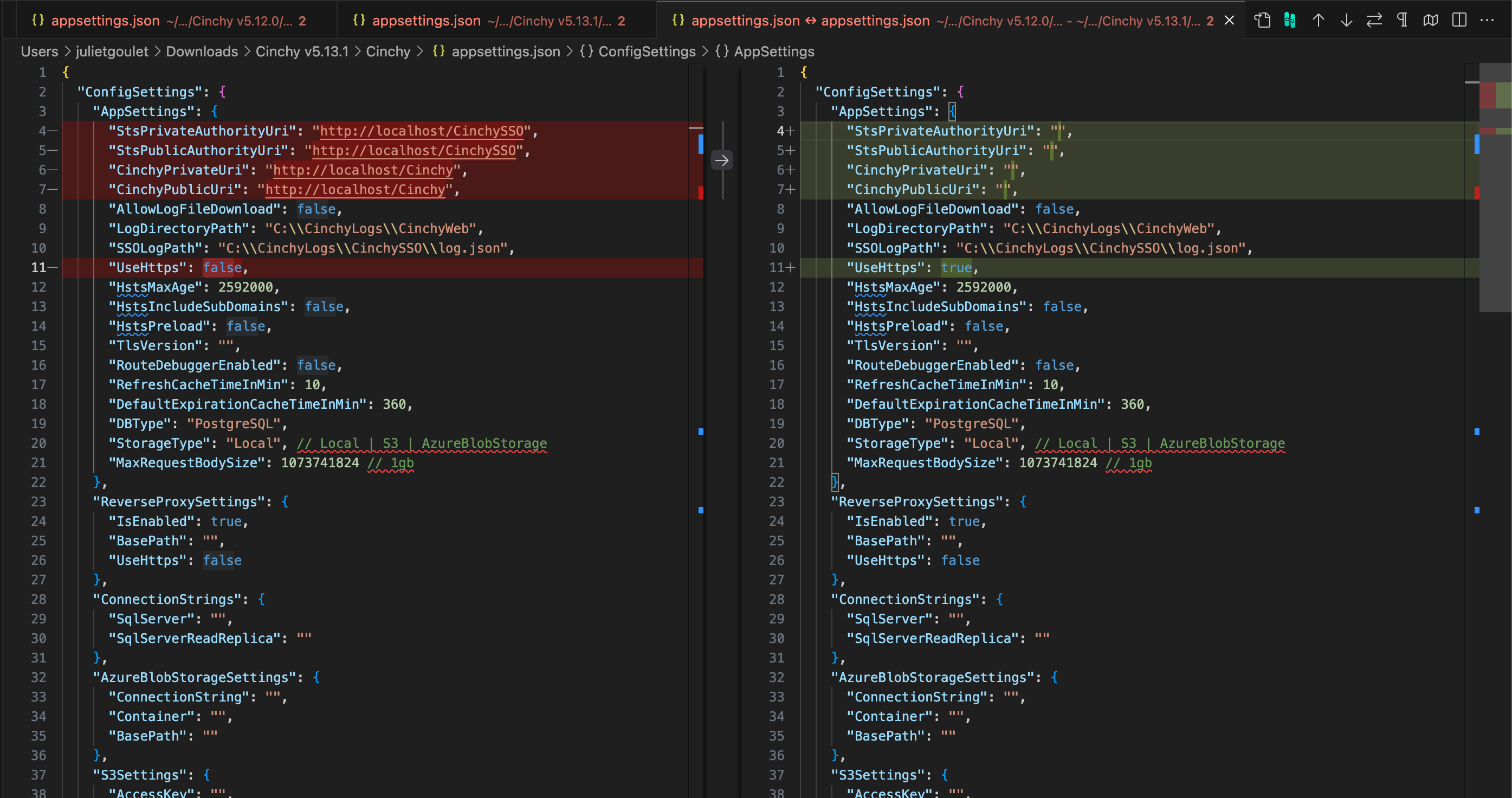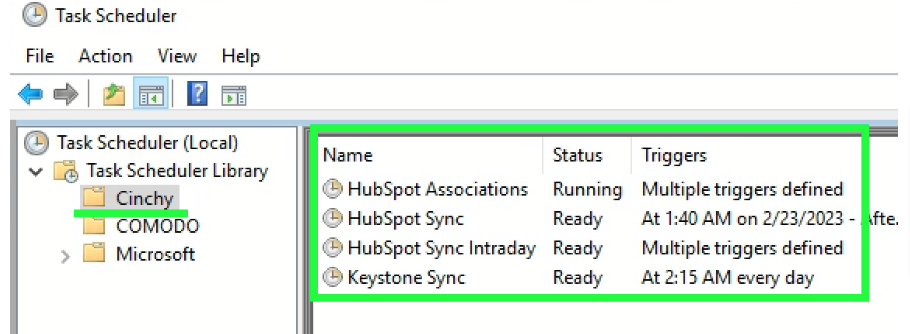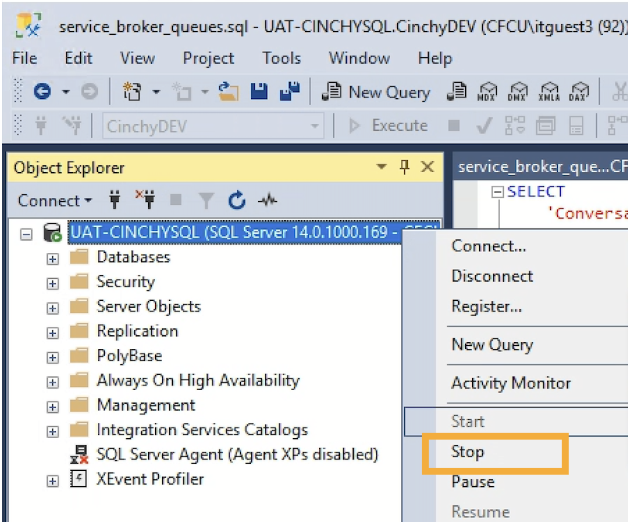v5.10 (IIS)
Upgrading on IIS
The following process can be run when upgrading any v5.x instance to v5.10 on IIS.
After upgrading to version 5.10 all users must log out and back in to your Cinchy environment in order for the changes to properly take effect.
When upgrading Cinchy Event Listener to version 5.10.0, note that the service name has changed. Please see the Event Listener Service Change section for further instructions.
Changes to Personal Access Tokens
There was an issue affecting Personal Access Tokens (PATs) generated in Cinchy wherein tokens created from v5.7 onwards were incompatible with subsequent versions of the platform. This issue has been resolved, however please note that:
- **Any tokens created on versions 5.7.x, 5.8.x, and 5.9.x will need to be regenerated.
- "401 Unauthorized" errors may indicate the need to regenerate the token.
- PATs created before 5.7.x and from 5.10 onwards are unaffected.
The upgrade of any version to Cinchy v5.10 may require changes to be made to various AppSetting files.
Prerequisites
If you have made custom changes to your deployment file structure, please contact your Support team before you upgrade your environments.
- Download the latest Cinchy Artifacts from the Cinchy Releases Table > Release Artifacts column. Check this into your file repository and make note of the path so that you can easily find it again later. (For example:
/Users/juliet/Desktop/Upgrades/Cinchy v5.10) - Download .NET 6.0 if not already installed.
Depending on your current version, you may need to:
- Run the 5.2 upgrade script
- Run the 5.5 upgrade script
- Make changes to your connection string:
If you are upgrading from 5.0-5.3 to 5.10 on an SQL Server Database, you will need to make a change to your connectionString in your SSO and Cinchy appsettings.json. Adding TrustServerCertificate=True will allow you to bypass the certificate chain during validation.
Ex:
"SqlServer" : "Server=MyServer;Database=Cinchy;User ID=cinchy;Password=password;Trusted_Connection=False;Connection Timeout=30;Min Pool Size=10;TrustServerCertificate=True"
| Current Version | Run the 5.2 Upgrade Script | Run the 5.5 Upgrade Script | Connection String Changes (SQL Server DB) |
|---|---|---|---|
| 5.0 | Yes | Yes | Yes |
| 5.1 | Yes | Yes | Yes |
| 5.2 | X | Yes | Yes |
| 5.3 | X | Yes | Yes |
| 5.4 | X | Yes | X |
| 5.5 | X | X | X |
| 5.6 | X | X | X |
| 5.7 | X | X | X |
| 5.8 | X | X | X |
| 5.9 | X | X | X |
Upgrade process
- Take a backup of your database.
- For an example on how to do so using SQL Server Management Studio, click here.
- Navigate to the new
Cinchy v5.10folder that was downloaded in the Prerequisites section of this guide. - From within the
Cinchy v5.10folder, navigate to the/Cinchy v5.10/Cinchy/appsettings.jsonfile. - Open the file in the text compare or merge utility tool of your choosing. (For example: VS Code.)
- Open the matching file from your current configuration files, for example
/Cinchy v5.9.x/Cinchy/appsettings.json, in the same text compare or merge utility tool. - Compare your old configuration to the new one, merging your settings into
/Cinchy v5.10/Cinchy/appsettings.json. For instructions on doing this with VS Code, click here.
For example, in the below screenshot we have opened two files in VS Code to compare.
The utility tool identifies any differences between the two files and highlights them in red; in this case our config information. Using the right arrow that appears between the two configs, we can tell VS Code to merge the differences from the old file into the new file. This prevents the manual re-entry of data.
Make sure to take note of any new section(s) that might appear in the new config as well, inputting values as necessary.
After repeating this for all of the differences, save the /Cinchy v5.10/Cinchy/appsettings.json file.

-
Repeat this process for the following configuration files, comparing and merging your settings into the new files:
/Cinchy v5.10/Cinchy/web.config/Cinchy v5.10/CinchySSO/appsettings.json/Cinchy v5.10/CinchySSO/web.config/Cinchy Connections v5.10.x/CinchyConnectionsWebApi/ClientApp/dist/index.html. This step ensures that the Connections Experience will load. Pay particular attention that the base path matches.
-
If you are upgrading to v5.10 on an SQL Server Database and didn't do so in any previous updates, you will need to make a change to your
connectionStringin both your SSO and Cinchy appsettings.json. Adding TrustServerCertificate=True will allow you to bypass the certificate chain during validation.Ex:
"SqlServer" : "Server=MyServer;Database=Cinchy;User ID=cinchy;Password=password;Trusted_Connection=False;Connection Timeout=30;Min Pool Size=10;TrustServerCertificate=True" -
When upgrading to 5.10, and if you didn't do so in any previous updates, you are required to make some changes to various appsettings.json files. If you made these changes on a prior upgrade please proceed to step 4. These changes are outlined in the following sections:
-
Navigate to your Connections Server. Stop the following services by clicking on them and then the square stop icon in the task bar:
- Cinchy Listener service.
- Cinchy Worker service.

-
If there are any sync jobs scheduled in the Windows Task Scheduler:
- Make a note of which jobs are scheduled, as a backup.
- Disable the jobs.

-
As an administrator, open a command line/terminal and execute the following command:
iisreset -stop
- Navigate to your Database Server.
- Stop the SQL Server Cinchy Database by right-clicking it and selecting
Stop.
- Replace your current/old Cinchy and CinchySSO folders with the new 5.10 folders, i.e.
/Cinchy v5.10/Cinchyand/Cinchy v5.10/CinchySSO. - Start the SQL Server Cinchy Database by right-clicking it and selecting
Start. - As an administrator, open a command line/terminal and execute the following command:
iisreset -start
- Re-enable any jobs in the Task Scheduler.
- Double check and re-enable any CDCs that may have turned off during the upgrade.
- Navigate to your Connections Server. Start the following services by clicking on them and then the triangle start icon in the task bar:
- Cinchy Listener service.
- Cinchy Worker service.
- Open your Cinchy URL in your browser.
- All users must log out and back in to your Cinchy environment in order for the changes to properly take effect.
Event Listener Service Change
When upgrading Cinchy Event Listener to version 5.10, note that the service name has changed. To ensure this change is properly reflected in the Windows Service, you need to follow these steps:
- Open a PowerShell 5.1 terminal within the CinchyEventListener deployment directory.
- Run the PowerShell file
remove-cinchy-event-listener-windows-service.ps1. - After removing the service, run the PowerShell file
create-cinchy-event-listener-windows-service.ps1 "path to CinchyEventListener".
If your Cinchy Event Listener is using a trusted connection, remember to update these details for the CinchyENV Event Listener service in the Services.msc control panel.
Support
If you encounter an error during this process, restore your database backup and contact Cinchy Support.